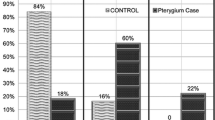Abstract
Pterygium is a chronic fibrovascular overgrowth on the corneal surface and is often associated with inflammation, astigmatism and obstructed vision. The common treatment is surgical removal but post-operative recurrences with more aggressive behavior are common. However, there is a controversy in the pathogenesis of primary pterygium between limbal stem cell failure versus proliferation. In this study, we explore the proliferative and migratory aptitude in pterygium by characterizing the growth and migration pattern of pterygial cells in the head (on the cornea), the neck (over the focal limbus), and the body (on the conjunctiva) epithelia of 12 full-length primary pterygia. Immunofluorescence and quantification analyses showed a spatial expression pattern of markers for stem cells, cell growth, and matrix metalloproteinases. Beside the basal epithelia in all three regions, p63αstrong cells were located in suprabasal layers in head, weak in the body and absent in neck. Pertinent cell proliferation in head than body epithelia was revealed by its higher colony-forming efficiency. ATP-binding cassette transporter glycoprotein family member-2 and cytokeratin-15 were found mainly in the body basal epithelia, similar to that in normal conjunctiva. Much fewer proliferating stem-like cells in the neck region supported the limbal failure as a cause of pterygium formation. Pax6, matrix metalloproteinase-2 and -9 were more expressed in the head than in the other two regions. Our results indicate the importance of pterygium head in tissue growth and invasion and its likely involvement in post-operation recurrence.






Similar content being viewed by others
References
Coroneo MT, Di Girolamo N, Wakefield D (1999) The pathogenesis of pterygia. Curr Opin Ophthalmol 10:282–288
Detorakis ET, Spandidos DA (2009) Pathogenetic mechanisms and treatment options for ophthalmic pterygium: trends and perspectives (Review). Int J Mol Med 23:439–447
Di Girolamo N, Chui J, Coroneo MT, Wakefield D (2004) Pathogenesis of pterygia: role of cytokines, growth factors, and matrix metalloproteinases. Prog Retin Eye Res 23:195–228
Dora N, Ou J, Kucerova R, Parisi I, West JD, Collinson JM (2008) PAX6 dosage effects on corneal development, growth, and wound healing. Dev Dyn 237:1295–1306
Dushku N, Reid TW (1994) Immunohistochemical evidence that human pterygia originate from an invasion of vimentin-expressing altered limbal epithelial basal cells. Curr Eye Res 13:473–481
Dushku N, John MK, Schultz GS, Reid TW (2001) Pterygia pathogenesis: corneal invasion by matrix metalloproteinase expressing altered limbal epithelial basal cells. Arch Ophthalmol 119:695–706
Garfias Y, Bautista-De Lucio VM, García C, Nava A, Villalvazo L, Jiménez-Martínez MC (2009) Study of the expression of CD30 in pterygia compared to healthy conjunctivas. Mol Vis 15:2068–2073
Grindley JC, Davidson DR, Hill RE (1995) The role of Pax-6 in eye and nasal development. Development 121:1433–1442
Hirst LW (2003) The treatment of pterygium. Surv Ophthalmol 48:145–180
Kase S, Osaki M, Sato I, Takahashi S, Nakanishi K, Yoshida K, Ito H, Ohno S (2007a) Immunolocalisation of E-cadherin and beta-catenin in human pterygium. Br J Ophthalmol 91:1209–1212
Kase S, Takahashi S, Sato I, Nakanishi K, Yoshida K, Ohno S (2007b) Expression of p27(KIP1) and cyclin D1, and cell proliferation in human pterygium. Br J Ophthalmol 91:958–961
Kwok LS, Coroneo MT (1994) A model for pterygium formation. Cornea 13:219–224
Lee GA, Hirst LW, Sheehan M (1994) Knowledge of sunlight effects on the eyes and protective behaviors in the general community. Ophthalmic Epidemiol 1:67–84
Li DQ, Lee SB, Gunja-Smith Z, Liu Y, Solomon A, Meller D, Tseng SC (2001) Overexpression of collagenase (MMP-1) and stromelysin (MMP-3) by pterygium head fibroblasts. Arch Ophthalmol 119:71–80
Li W, Chen YT, Hayashida Y, Blanco G, Kheirkah A, He H, Chen SY, Liu CY, Tseng SC (2008) Down-regulation of Pax6 is associated with abnormal differentiation of corneal epithelial cells in severe ocular surface diseases. J Pathol 214:114–122
Massova I, Kotra LP, Fridman R, Mobashery S (1998) Matrix metalloproteinases: structures, evolution, and diversification. FASEB J 12:1075–1095
Morrison CJ, Butler GS, Rodriguez D, Overall CM (2009) Matrix metalloproteinase proteomics: substrates, targets, and therapy. Curr Opin Cell Biol 21:645–653
Ramaesh T, Ramaesh K, Collinson MJ, Chanas SA, Dhillon B, West JD (2005) Developmental and cellular factors underlying corneal epithelial dysgenesis in the Pax6± mouse model of aniridia. Exp Eye Res 81:224–235
Ramalho FS, Maestri C, Ramalho LN, Ribeiro-Silva A, Romao E (2006) Expression of p63 and p16 in primary and recurrent pterygia. Graefes Arch Clin Exp Ophthalmol 244:1310–1314
Sakoonwatanyoo P, Tan DT, Smith DR (2004) Expression of p63 in pterygium and normal conjunctiva. Cornea 23:67–70
Tsai YY, Chiang CC, Yeh KT, Lee H, Cheng YW (2010) TIMP 1 neutralizes MMPs activity to inhibit pterygium invasion. Invest Ophthalmol Vis Sci 51:3462–3467
Westermarck J, Kahari VM (1999) Regulation of matrix metalloproteinase expression in tumor invasion. FASEB J 13:781–792
Yang SF, Lin CY, Yang PY, Chao SC, Ye YZ, Hu DN (2009) Increased expression of gelatinase (MMP-2 and MMP-9) in pterygia and pterygium fibroblasts with disease progression and activation of protein kinase C. Invest Ophthalmol Vis Sci 50:4588–4596
Acknowledgments
We thank Dr. W. Y. Li and the Ocular Pathology Service (Chinese University of Hong Kong) for the pterygium archive specimens. We are grateful to Prof. H. Cheung (University of Miami, USA) for the critical reading and comments on this manuscript.
Author information
Authors and Affiliations
Corresponding author
Additional information
H. Bai and Y. Teng have contributed equally to this work.
Rights and permissions
About this article
Cite this article
Bai, H., Teng, Y., Wong, L. et al. Proliferative and migratory aptitude in pterygium. Histochem Cell Biol 134, 527–535 (2010). https://doi.org/10.1007/s00418-010-0751-5
Accepted:
Published:
Issue Date:
DOI: https://doi.org/10.1007/s00418-010-0751-5




